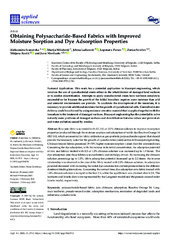Приказ основних података о документу
Obtaining Polysaccharide-Based Fabrics with Improved Moisture Sorption and Dye Adsorption Properties
| dc.creator | Ivanovska, Aleksandra | |
| dc.creator | Milošević, Marija | |
| dc.creator | Lađarević, Jelena | |
| dc.creator | Pavun, Leposava | |
| dc.creator | Svirčev, Zorica | |
| dc.creator | Kostić, Mirjana | |
| dc.creator | Meriluoto, Jussi | |
| dc.date.accessioned | 2023-03-20T13:59:45Z | |
| dc.date.available | 2023-03-20T13:59:45Z | |
| dc.date.issued | 2023 | |
| dc.identifier.issn | 2076-3417 | |
| dc.identifier.uri | http://TechnoRep.tmf.bg.ac.rs/handle/123456789/6220 | |
| dc.description.abstract | Raw jute fabric was treated with 0.5, 1.0, or 2.0% chitosan solution to improve its sorption properties (evaluated through the moisture sorption and adsorption of textile dye Reactive Orange 16 (RO 16)), which are essential for fabric utilization as geo-prebiotic polysaccharide support that should provide the necessary water for the growth of cyanobacterial communities in biocarpet engineering. Chitosan-treated fabrics possessed 39–78% higher moisture sorption values than the untreated ones. Concerning the dye adsorption, with the increase in its initial concentration, the adsorption potential of raw and fabrics treated with 0.5 or 1.0% chitosan solution was increased up to 1.9 times. The dye adsorption onto these fabrics was exothermic and enthalpy driven. By increasing the chitosan solution percentage up to 1.0%, fabric adsorption potential increased up to 2.2 times. An inverse relationship was observed in the case of the fabric treated with 2.0% chitosan solution, its adsorption potential decreased with increasing the initial dye concentration and temperature due to the different dominant binding interactions. Concerning the contact time, dye adsorption onto fabric treated with 1.0% chitosan solution was rapid in the first 2 h, while the equilibrium was attained after 4.5 h. The isotherm and kinetic data were represented by the Langmuir model and the pseudo-second-order kinetic model, respectively. | sr |
| dc.language.iso | en | sr |
| dc.publisher | MDPI | sr |
| dc.relation | info:eu-repo/grantAgreement/ScienceFundRS/Ideje/7726976/RS// | sr |
| dc.relation | info:eu-repo/grantAgreement/MESTD/inst-2020/200287/RS// | sr |
| dc.relation | info:eu-repo/grantAgreement/MESTD/inst-2020/200135/RS// | sr |
| dc.relation | info:eu-repo/grantAgreement/MESTD/inst-2020/200161/RS// | sr |
| dc.rights | openAccess | sr |
| dc.rights.uri | https://creativecommons.org/licenses/by/4.0/ | |
| dc.source | Applied Sciences | sr |
| dc.subject | adsorption | sr |
| dc.subject | adsorption mechanism | sr |
| dc.subject | chitosan | sr |
| dc.subject | cyanobacteria | sr |
| dc.subject | jute | sr |
| dc.subject | Langmuir isotherm | sr |
| dc.subject | polysaccharide-based fabric | sr |
| dc.subject | pseudo-second order | sr |
| dc.subject | Reactive Orange 16 | sr |
| dc.subject | restoration of degraded lands and substrates | sr |
| dc.title | Obtaining Polysaccharide-Based Fabrics with Improved Moisture Sorption and Dye Adsorption Properties | sr |
| dc.type | article | sr |
| dc.rights.license | BY | sr |
| dc.citation.issue | 4 | |
| dc.citation.rank | M22~ | |
| dc.citation.spage | 2512 | |
| dc.citation.volume | 13 | |
| dc.identifier.doi | 10.3390/app13042512 | |
| dc.identifier.fulltext | http://TechnoRep.tmf.bg.ac.rs/bitstream/id/16536/Obtaining_Polysaccharide_Based_PUB_2023.pdf | |
| dc.identifier.scopus | 2-s2.0-85149287598 | |
| dc.type.version | publishedVersion | sr |

